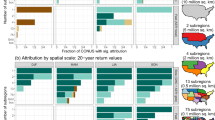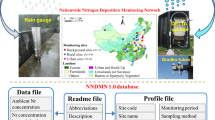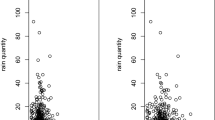Abstract
Pathways for the transfer of pollutants from the atmosphere to vegetation by gaseous absorption (dry deposition) and in rain (wet deposition) have been studied extensively. Here we quantify deposition by a third pathway, that which occurs when vegetation exposed in wind-driven cloud intercepts water drops which are not collected efficiently in standard rain gauges1. From measurements of the chemical content and rate of this ‘occult precipitation’2 at Great Dun Fell, Cumbria in the United Kingdom, we make preliminary estimates of the deposition of several elements. We tentatively conclude that the inclusion of the occult deposition pathway in assessing annual chemical deposition in areas prone to low cloud could increase wet deposition estimates by up to 20% from values recorded in conventional rainfall chemistry gauges alone.
This is a preview of subscription content, access via your institution
Access options
Subscribe to this journal
Receive 51 print issues and online access
$199.00 per year
only $3.90 per issue
Buy this article
- Purchase on Springer Link
- Instant access to full article PDF
Prices may be subject to local taxes which are calculated during checkout
Similar content being viewed by others
References
Nagel, J. F. Q. Jl R. met. Soc. 82, 452–460 (1956).
Rutter, A. J. in Vegetation and the Atmosphere Vol. 1 (ed. Monteith, J. L.) 111–154 (Academic, London 1975).
Kerfoot, O. For. Abstr. 29, 8–20 (1968).
Okita, T. J. met. Soc. Japan 46, 120–127 (1968).
Kirchaite, A., Shopauskas, K. & Gedraitis, V. Zaschita Atmosfery ot Zagryaznenii 1, 64–83 (1974).
Mrose, H. Tellus 18, 266–270 (1966).
Tomlinson, G. H., Brauzes, R. J. P., McLean, R. A. H. & Kadlecek, J. in Ecological Impact of Acid Precipitation (eds Drablos, D & Tollan, A.) 134–137 (SNSF Project, Oslo, Norway 1980).
Thom, A. in Vegetation and the Atmosphere Vol. 1 (ed. Monteith, J. L.) 57–109 (Academic, London 1975).
Dollard, G. J. & Unsworth, M. H. Atmos. Envir. (in the press).
Heal, O. W. & Smith, R. A. H. in Production Ecology of British Moors and Montane Grasslands (eds Heal, O. W. & Perkins, D. F.) 3–16 (Springer, New York 1978).
May, K. R. Q. Jl. R. met. Soc. 87, 535–548 (1961).
Stevenson, C. M. Q. Jl. R. met. Soc. 94, 56–70 (1968).
Cawse, P. A. AERE Report No R8038 (HMSO, London, 1975).
Dovland, H., Joranger, E. & Semb, A. in Impact of Acid Precipitation on Forest and Fresh Water Ecosystems in Norway (ed. Braekke, F. H.) 14–35 (SNSF Project, Oslo, Norway 1976).
Likens, G. E., Wright, R. F., Galloway, J. H. & Butler, T. J. Scient. Am. 241, 39–47 (1979).
Fowler, D., Cape, J. N., Leith, I. D., Paterson, I. S., Kinnaird, J. W. & Nicholson, I. A. Nature 297, 383–386 (1982).
Corbin, R. C., Latham, J., Mill, C. S. & Stromberg, I. M. Q. Jl A. met. Soc. 104, 729–736 (1978).
Martin, A. Envir. Pollut. B1, 177–179 (1980).
Gore, A. J. P. J. Ecol. 56, 483–495 (1968).
Author information
Authors and Affiliations
Rights and permissions
About this article
Cite this article
Dollard, G., Unsworth, M. & Harve, M. Pollutant transfer in upland regions by occult precipitation. Nature 302, 241–243 (1983). https://doi.org/10.1038/302241a0
Received:
Accepted:
Issue Date:
DOI: https://doi.org/10.1038/302241a0
This article is cited by
-
Medium, Vector, and Connector: Fog and the Maintenance of Ecosystems
Ecosystems (2020)
-
Additive impacts of nitrogen deposition and grazing on a mountain moss-sedge heath
Botanica Helvetica (2010)
-
An automated fog water collector suitable for deposition networks: Design, operation and field tests
Water, Air, & Soil Pollution (1997)
-
The measurement of atmospheric concentrations and deposition of semi-volatile organic compounds
Environmental Monitoring and Assessment (1994)
-
Wolke und Nebel
Umweltwissenschaften und Schadstoff-Forschung (1991)
Comments
By submitting a comment you agree to abide by our Terms and Community Guidelines. If you find something abusive or that does not comply with our terms or guidelines please flag it as inappropriate.



